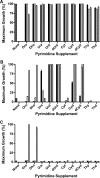Genetic dissection of pyrimidine biosynthesis and salvage in Leishmania donovani
- PMID: 22367196
- PMCID: PMC3339959
- DOI: 10.1074/jbc.M112.346502
Genetic dissection of pyrimidine biosynthesis and salvage in Leishmania donovani
Abstract
Protozoan parasites of the Leishmania genus express the metabolic machinery to synthesize pyrimidine nucleotides via both de novo and salvage pathways. To evaluate the relative contributions of pyrimidine biosynthesis and salvage to pyrimidine homeostasis in both life cycle stages of Leishmania donovani, individual mutant lines deficient in either carbamoyl phosphate synthetase (CPS), the first enzyme in pyrimidine biosynthesis, uracil phosphoribosyltransferase (UPRT), a salvage enzyme, or both CPS and UPRT were constructed. The Δcps lesion conferred pyrimidine auxotrophy and a growth requirement for medium supplementation with one of a plethora of pyrimidine nucleosides or nucleobases, although only dihydroorotate or orotate could circumvent the pyrimidine auxotrophy of the Δcps/Δuprt double knockout. The Δuprt null mutant was prototrophic for pyrimidines but could not salvage uracil or any pyrimidine nucleoside. The capability of the Δcps parasites to infect mice was somewhat diminished but still robust, indicating active pyrimidine salvage by the amastigote form of the parasite, but the Δcps/Δuprt mutant was completely attenuated with no persistent parasites detected after a 4-week infection. Complementation of the Δcps/Δuprt clone with either CPS or UPRT restored infectivity. These data establish that an intact pyrimidine biosynthesis pathway is essential for the growth of the promastigote form of L. donovani in culture, that all uracil and pyrimidine nucleoside salvage in the parasite is mediated by UPRT, and that both the biosynthetic and salvage pathways contribute to a robust infection of the mammalian host by the amastigote. These findings impact potential therapeutic design and vaccine strategies for visceral leishmaniasis.
Figures








Similar articles
-
Substrate inhibition of uracil phosphoribosyltransferase by uracil can account for the uracil growth sensitivity of Leishmania donovani pyrimidine auxotrophs.J Biol Chem. 2013 Oct 11;288(41):29954-64. doi: 10.1074/jbc.M113.478826. Epub 2013 Aug 28. J Biol Chem. 2013. PMID: 23986453 Free PMC article.
-
Profiles of pyrimidine biosynthesis, salvage and degradation in disks of potato (Solanum tuberosum L.) tubers.Planta. 2002 Sep;215(5):821-8. doi: 10.1007/s00425-002-0806-5. Epub 2002 Jun 21. Planta. 2002. PMID: 12244448
-
Physiological characterization of a pyrimidine auxotroph exposes link between uracil phosphoribosyltransferase regulation and riboflavin production in Ashbya gossypii.N Biotechnol. 2019 May 25;50:1-8. doi: 10.1016/j.nbt.2018.12.004. Epub 2018 Dec 24. N Biotechnol. 2019. PMID: 30590201
-
Generation of growth arrested Leishmania amastigotes: a tool to develop live attenuated vaccine candidates against visceral leishmaniasis.Vaccine. 2014 Jun 30;32(31):3895-901. doi: 10.1016/j.vaccine.2014.05.009. Epub 2014 May 14. Vaccine. 2014. PMID: 24837513 Review.
-
Antiparasitic chemotherapy: tinkering with the purine salvage pathway.Adv Exp Med Biol. 2008;625:116-32. doi: 10.1007/978-0-387-77570-8_10. Adv Exp Med Biol. 2008. PMID: 18365663 Review.
Cited by
-
Leishmania infantum Asparagine Synthetase A Is Dispensable for Parasites Survival and Infectivity.PLoS Negl Trop Dis. 2016 Jan 15;10(1):e0004365. doi: 10.1371/journal.pntd.0004365. eCollection 2016 Jan. PLoS Negl Trop Dis. 2016. PMID: 26771178 Free PMC article.
-
Systematic identification of genes encoding cell surface and secreted proteins that are essential for in vitro growth and infection in Leishmania donovani.PLoS Pathog. 2022 Feb 24;18(2):e1010364. doi: 10.1371/journal.ppat.1010364. eCollection 2022 Feb. PLoS Pathog. 2022. PMID: 35202447 Free PMC article.
-
Toxoplasma gondii C2 Domain Protein Deletion Mutant as a Promising Vaccine Against Toxoplasmosis in Mice.Microb Biotechnol. 2025 May;18(5):e70143. doi: 10.1111/1751-7915.70143. Microb Biotechnol. 2025. PMID: 40407413 Free PMC article.
-
In silico prediction of the metabolism of Blastocrithidia nonstop, a trypanosomatid with non-canonical genetic code.BMC Genomics. 2024 Feb 16;25(1):184. doi: 10.1186/s12864-024-10094-8. BMC Genomics. 2024. PMID: 38365628 Free PMC article.
-
Pyrimidine metabolism in schistosomes: A comparison with other parasites and the search for potential chemotherapeutic targets.Comp Biochem Physiol B Biochem Mol Biol. 2017 Nov;213:55-80. doi: 10.1016/j.cbpb.2017.07.001. Epub 2017 Jul 21. Comp Biochem Physiol B Biochem Mol Biol. 2017. PMID: 28735972 Free PMC article. Review.
References
-
- Carter N., Rager N, Ullman B. (2003) Purine and pyrimidine transport and metabolism. in Molecular and Medical Parasitology (Marr J. J., Nilsen T. W., Komuniecki R., eds) pp. 197–223, Academic Press Ltd., London
-
- Hammond D. J., Gutteridge W. E. (1980) Enzymes of pyrimidine biosynthesis in Trypanosoma cruzi. FEBS Lett. 118, 259–262 - PubMed
-
- Nara T., Gao G., Yamasaki H., Nakajima-Shimada J., Aoki T. (1998) Carbamoyl-phosphate synthetase II in kinetoplastids. Biochim. Biophys. Acta 1387, 462–468 - PubMed
-
- Aronow B., Kaur K., McCartan K., Ullman B. (1987) Two high affinity nucleoside transporters in Leishmania donovani. Mol. Biochem. Parasitol. 22, 29–37 - PubMed
-
- Papageorgiou I. G., Yakob L., Al Salabi M. I., Diallinas G., Soteriadou K. P., De Koning H. P. (2005) Identification of the first pyrimidine nucleobase transporter in Leishmania. Similarities with the Trypanosoma brucei U1 transporter and antileishmanial activity of uracil analogues. Parasitology 130, 275–283 - PubMed
Publication types
MeSH terms
Substances
Associated data
- Actions
Grants and funding
LinkOut - more resources
Full Text Sources

